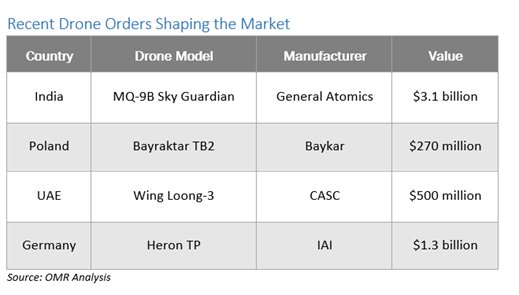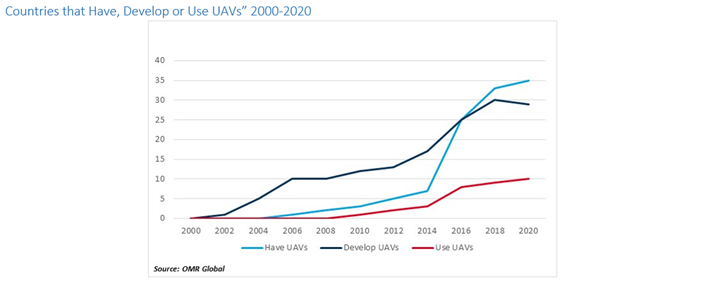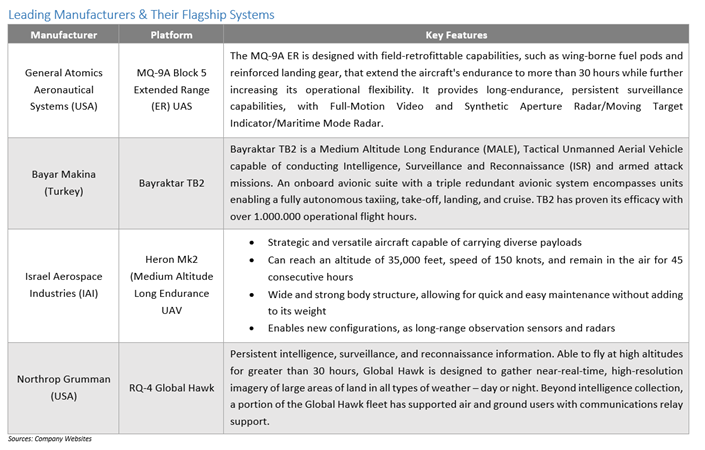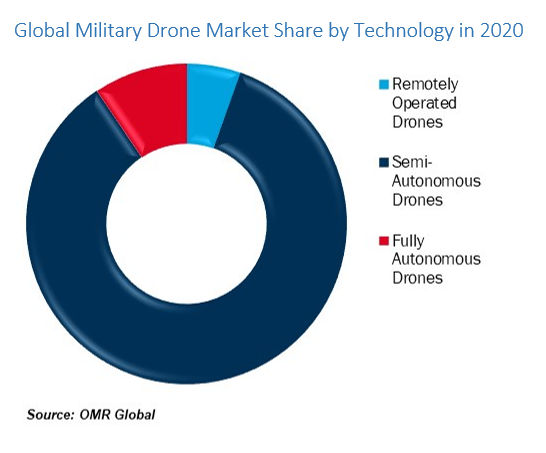How Drones Are Changing Modern Warfare: Silent Skies, Strategic Strikes
Global military drones market is experiencing substantial growth of 12.8%, driven primarily by the increasing adoption of unmanned systems across the defense sectors. The development and integration of drones, or unmanned aerial vehicles (UAVs), into military forces is fundamentally reshaping modern warfare. UAVs offer state-of-the-art capabilities, improving the effectiveness of forces while keeping human resources out of harm's way. Military drones that are armed with advanced sensors and cutting-edge technologies have shown incredible versatility in conducting various missions, leading countries across the globe to hasten their acquisition and development of these systems.
As more and more countries start to manufacture or operate drones, the future of the global drone industry seems promising. The international military drone market is projected to rise from $11.25 billion in 2021 to $26.12 billion in 2028 at a CAGR of 12.78%. Some studies even estimate the mid-2020s market size as large as $58.5 billion. Currently, over 100 countries operate various drones20, and forecasts anticipate that this number will grow in the coming years.

Click to get a Sample PDF (Including Full TOC, Graphs & Charts, Table & Figures) @ https://www.omrglobal.com/request-sample/military-drones-market
Why Military Drone Demand Is Soaring
Force Multiplication & Risk Reduction: UAVs such as the Turkish Bayraktar TB2 allow small units to launch precision strikes and ISR (Intelligence, Surveillance, Reconnaissance) in front of ground forces, reducing casualties and speeding up decision-cycles
Asymmetric Warfare & Deterrence: Adversaries—be they near-peer militaries or non-state actors—use cheap drones for spying and kamikaze missions, forcing great powers to deploy more advanced UAVs to ensure air superiority and guard high-value targets.
Cost-Effective Persistent Surveillance: The unmanned vehicle can linger for over 30 hours at altitudes higher than 40,000 ft, getting up-to-date Intel without risking the lives of pilots. This sort of endurance nullifies the need for multiple manned sorties and reduces operating costs.

Impact on Current Conflicts: The Battlefield Revolution
India-Pakistan Conflicts: Armed drones increasingly differentiate the dynamics of conflict between India and Pakistan. Both nations have adopted the use of drone technology to advance their reconnaissance, surveillance, and limited offensive capabilities, particularly in the volatile and sensitive areas along the Line of Control (LoC). The frequent interceptions and sightings of drones along the India-Pakistan border indicate the growing use of UAVs in tactical operations. There have been several instances of Pakistani drones entering Indian airspace, allegedly used for smuggling weapons, explosives, and narcotics. These incidents indicate how drones are not only military intelligence assets but also asymmetric warfare assets. Both countries are also using drone-borne imagery and video as part of their strategic communication and psychological operations.
India has been actively training UAVs such as the Israeli IAI Heron and Searcher drones for long-range reconnaissance missions. These medium-altitude, long-endurance drones are deployed largely in the Indian Army, Air Force, and Navy. India is also developing new drones such as the Rustom and TAPAS-BH-201 under the Defence Research and Development Organisation (DRDO). Further, India is acquiring MQ-9B SeaGuardian/Predator-B drones from the US that can perform precision strikes and long-duration surveillance missions. Against intrusions from the other side, India has also installed anti-drone systems at key points, particularly in Punjab and Jammu & Kashmir, to counter drones for smuggling or surveillance by the enemy.
Pakistan, nonetheless, has designed and operated a series of native UAV platforms like Shahpar and Uqab for surveillance and reconnaissance missions. Pakistan has also procured advanced UAVs from China, like the CH-4 and Wing Loong drones, which have been reportedly used for precision strikes. One of the most advanced in the Pakistani drone program is the Burraq UCAV, a Chinese-assisted armed drone with laser-guided missiles (Barq).
Russia-Ukraine War: The war between Russia and Ukraine has recently served as an important proving ground for drone combat, demonstrating their revolutionary effect on contemporary military confrontations. The Turkish Bayraktar TB2 UCAVs, among other drone systems, have strategically been integrated by Ukraine into its military defense stock since 2021.
At that time, Ukrainian Defense Minister Andriy Taran confirmed the purchase, commenting: "The first Bayraktar TB2 UCAV complex arrived in Ukrain Navy. The Ukrainian commander of the navy, Oleksiy Neizhpapa, characterized the purchase as "a step ahead," stressing that "the Navy, as any other type/breed of the Armed Forces, such as the whole civil world, makes a transition to unmanned technologies.
Recently, Ukraine has further increased its drone capacities. The Ministry of Defence in Ukraine has implemented "bomber" drones called B-1, which are referred to as "ultra-lightweight 'bombers' aimed at attacking clusters of enemy personnel, automotive vehicles, and armored machinery". Furthermore, the Drone Coalition has issued its third international tender exclusively targeting tactical-level multi-rotor intelligence, surveillance, and reconnaissance drones (ISR).
By 2024, the Ministry of Defence of Ukraine had already adopted and operated more than 300 models of UAVs of various types, including reconnaissance drones, strike drones, ‘kamikaze’ drones, and loitering munitions.

Financial Imperatives
The financial imperatives of using drones are compelling. They offer cheaper alternatives to traditional military systems, creating cost-imposing strategies that can financially burden adversaries. In a long and large conflict, cost is key: the fewer resources used to destroy a target, the better. Defeating a $500 drone with a $3M missile may be effective, but not sustainable. As quantity matters, the more drones a state can produce, the more sustainable its drone operations and the more credible its threat to stay the course.
UAVs provide cost-effective alternatives to traditional military systems, offering significant financial benefits. They impose financial burdens on adversaries by requiring them to use expensive countermeasures against inexpensive drones. Most Western militaries consist of a small number of very expensive assets. For instance, approximately seventy $20 million Abrams tanks in Australia can be defeated with $700 drones, which means that there is no need to be a sophisticated player to pose a credible threat.

For Full Report Description + Research Methodology + Table of Content + Infographics @ https://www.omrglobal.com/buy-now/military-drones-market?license_type=license-multi-user
Conclusion
The use of drones in warfare is a paradigm shift in contemporary warfare. From the battlefields of Ukraine to the tense airspaces over South Asia, unmanned aerial vehicles are changing the nature of conflict and conflict resolution. The synergy of persistent surveillance capabilities, precision strike options, lowered risk to personnel, and cost-effectiveness compared to many conventional military platforms makes drones an attractive investment for defense ministries across the globe.